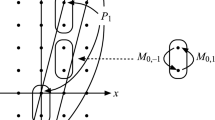Abstract
The Young’s and torsion moduli of single-layer carbon (m, 0) and (m, m) nanotubes are studied. It is demonstrated that both moduli depend on the chirality, diameter, and length of the nanotube. It is found for the first time that the torsion modulus increases with the nanotube diameter and diminishes with an increase in its length. By considering nanotubes with various values of the diameter-to-length ratio, it is shown that the Young’s and torsion moduli of the nanotubes saturate at a diameter-to-length ratio of ∼0.3. The values of the torsion modulus as calculated from the Young’s modulus we obtained and from the deformation energy do not coincide, which can be attributed to the effect of dangling bonds at the open ends of the nanotubes. Energy calculations are performed using the Goodwin modification of the semiempirical Harrison tight-binding method.
Similar content being viewed by others
References
M. J. Treacy, T. W. Ebbsen, and J. M. Gibson, Nature (London) 381, 678 (1996).
A. Krishnan, E. Dujardin, T. W. Ebbesen, P. N. Yianilos, and M. M. J. Treacy, Phys. Rev. B: Condens. Matter 58(20), 14013 (1998).
E. W. Wong, P. E. Sheehan, and C. M. Lieber, Science (Washington), 277(5334), 1971 (1997).
J.-P. Salvetat, G. A. D. Briggs, J.-M. Bonard, R. R. Bacsa, A. J. Kulik, T. Stöckli, N. A. Burnham, and L. Forró, Phys. Rev. Lett. 82(5), 944 (1999).
Zhou Xin, Zhou Jianjun, and Ou-Yang Zhong-can, Phys. Rev. B: Condens. Matter 62(20), 13692 (2000).
J. P. Lu, Phys. Rev. Lett. 79(7), 1297 (1997).
K. M. Liew, X. Q. He, and C. H. Wong, Acta Mater. 52(17), 2521 (2004).
Marc Dequesnes, S. V. Rotkin, and N. R. Aluru, Nanotechnology 13, 120 (2002).
Lianxi Shen and Jackie Li, Phys. Rev. B: Condens. Matter 69, 045414 (2004).
Rodney S. Ruoff, Dong Qian, and Wing Kam Liu, C. R. Phys. 4, 993 (2003).
C. F. Cornwell and L. T. Wille, Solid State Commun. 101, 555 (1997).
B. I. Yakobson, C. J. Brabec, and J. Bernholc, Phys. Rev. Lett. 76(14), 2511 (1996).
E. Hernandez, C. Goze, P. Bernier, and A. Rubio, Phys. Rev. Lett. 80(20), 4502 (1998).
Tobias Hertel, Robert E. Walkup, and Phedon Avouris, Phys. Rev. B: Condens. Matter 58(20), 13870 (1998).
N. M. Harik, Comput. Mater. Sci. 24, 328 (2002).
O. E. Glukhova and A. I. Zhbanov, Fiz. Tverd. Tela (St. Petersburg) 45(1), 180 (2003) [Phys. Solid State 45 (1), 189 (2003)].
O. E. Glukhova, A. I. Zhbanov, and A. G. Rezkov, Fiz. Tverd. Tela (St. Petersburg) 47(2), 376 (2005) [Phys. Solid State 47 (2), 390 (2005)].
S. Han and J. Ihm, Phys. Rev. B: Condens. Matter 61(15), 9986 (2000).
L. Goodwin, J. Phys.: Condens. Matter. 3, 3869 (1991).
L. D. Landau and E. M. Lifshitz, Course of Theoretical Physics, Vol. 7: Theory of Elasticity (Pergamon, Oxford, 1986; Nauka, Moscow, 2001).
C. Q. Ru, Phys. Rev. B: Condens. Matter 62(15), 9973 (2000).
H. Dai, J. H. Hafner, A. G. Rinzler, D. T. Colbert, and R. E. Smalley, Nature (London) 384, 147 (1996).
Author information
Authors and Affiliations
Additional information
Original Russian Text © O.E. Glukhova, O.A. Terent’ev, 2006, published in Fizika Tverdogo Tela, 2006, Vol. 48, No. 7, pp. 1329–1335.
Rights and permissions
About this article
Cite this article
Glukhova, O.E., Terent’ev, O.A. Theoretical study of the dependences of the young’s and torsion moduli of thin single-layer carbon zigzag and armchair nanotubes on the geometric parameters. Phys. Solid State 48, 1411–1417 (2006). https://doi.org/10.1134/S1063783406070304
Received:
Accepted:
Issue Date:
DOI: https://doi.org/10.1134/S1063783406070304




